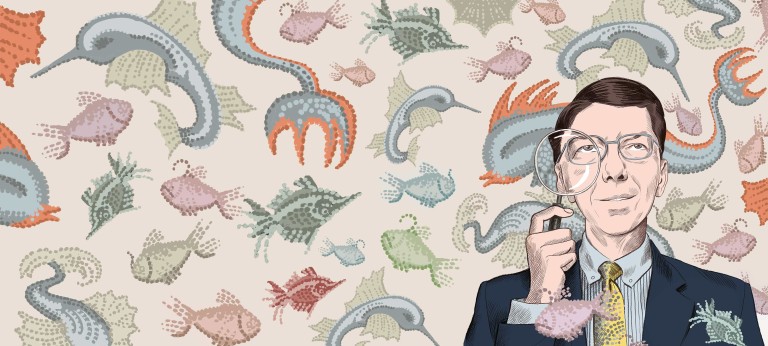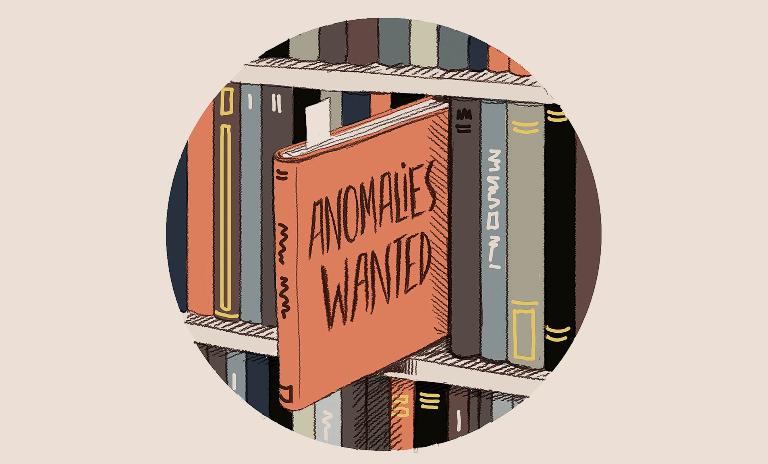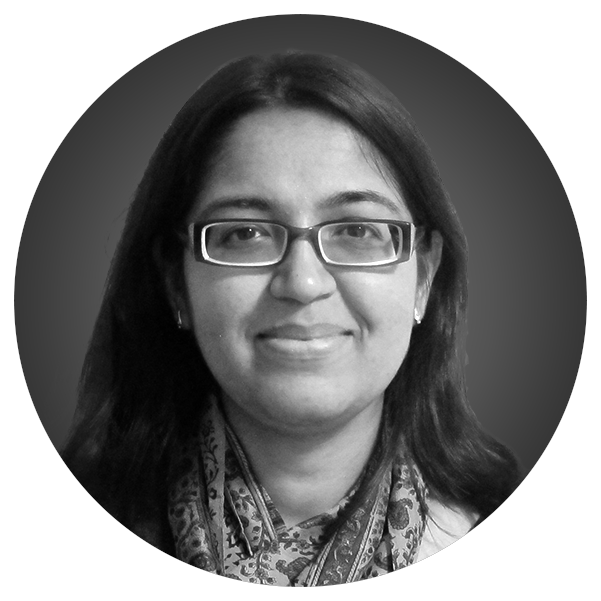Your path to tomorrow, today
![{[downloads[language].preview]}](https://www.rolandberger.com/publications/publication_image/tam_future_cover_en_download_preview.jpg)
The actions of the present lay the foundations for the future. What does this saying mean in turbulent times? Consider a mix of solidity and flexibility!


by Neelima Mahajan
illustrations by Jeanne Detallante
With one of the sharpest minds in business, Clayton Christensen has dedicated his life to stimulating ideas. While he has had his own setbacks, he's still out in front with thinking that could yet change the world.
As you make your way to Clayton Christensen's office at Harvard Business School, you will pass an impressive artifact: a huge 4th century Roman mosaic, 6.5 meters in diameter, removed from the ancient city of Antioch and finally reassembled here across the floor. The artwork depicts the ocean goddess Tethys, serene and surrounded by sea creatures. In many ways it's a fitting image to set the tone before meeting Christensen. Not only is he a titan of his field with other people's ideas floating around him, but in the same way that this mosaic builds a bigger picture out of smaller fragments, so have Christensen's ideas cumulatively created a wave of influence that is both impressive and unparalleled.
Over a 25-year period, the business guru has focused his sharp mind on the power of innovation in business. In 1995, he coined the theory of disruptive innovation to explain why some companies with fewer resources can dethrone successful, well-entrenched ones. He explored how they were able to do so by focusing on market segments that had been ignored and employing new business models, new technologies or using old technologies in new ways. From that idea, he has built up a larger picture of what innovation can achieve through a series of best-selling books including "The Innovator's Dilemma", "The Innovator's Solution" and "Seeing What's Next".
"When the theories begin to shift, we have to change course as well."
Did he ever expect his theory to take off in the way it did? "We didn't have any aspirations for the theory at all," he says humbly, looking back on how that first idea took hold in 1995. He then goes on explain what has driven him to produce such effective theories: "The only way we can identify the future is if we have theories. The second thing is we are looking for anomalies, anything the theory cannot explain. That causes us to figure out why and then explore the theory so it does explain it."
Anomalies are clearly important to him, and his office proves it. It's filled with objects which offer an alternative mosaic picture that reveals a life well lived, an inquiring mind and a hint of his own personal setbacks. Bookshelves line the walls with titles showing a hunger for new ideas, there's a basketball in a case – a testament to his skill as an accomplished player – and next to his desk, there's a framed photo of him on the cover of Forbes magazine titled: "The Survivor". It gestures at how this 2-meter giant has had to dodge the curveballs life has thrown at him. A diabetic for decades, he dealt with a heart attack, cancer and a stroke: three life-changing incidents in as many years. He has refused to let his health hold him back and part of his solution has been to work with collaborators including Efosa Ojomo, co-author with Karen Dillon of their new book, "The Prosperity Paradox". Ojomo is present during this discussion to help him set out some of his ideas.
Twice ranked No. 1 in the Thinkers50, Clayton Christensen is widely regarded as the world's most influential expert in innovation. His groundbreaking ideas have led to nine best-selling books and four successful companies, including the Innosight consulting firm and the non-profit think tank, The Christensen Institute.
Even so, Christensen has stood steadfast in this constantly shape-shifting world, both personally with his own setbacks and in a wider context where business ideas are also in flux. His appeal lies in logic so clear that it busts confounding phenomena down to easy-to-understand theories. "You really can see the future if you have a good theory," he says softly. So, how does that apply in an age of hyperacceleration where you are only as good as your last idea? What implications do fast business cycles have for the idea of disruption? "Well, it's hard to know," he says thoughtfully. "My belief however is that one of the theories in our research is interdependence and modularity: If you have an interdependent product, then you have to do everything in order to do anything. If you are modular and open then you can be fast and flexible and responsive. And my sense is what we are seeing and what we think is accelerated growth, it's really the manifestation of interdependence and modularity."
It's his innovation ideas that get more of an airing in his latest work, where he and his collaborators are applying his innovation theories to solve global poverty. Before you can understand how they might do that, you need to know that at the heart of Christensen's thinking is the idea that not all innovations are equal. He distinguishes between three kinds of innovation. First are efficiency innovations, which help make good products cheaper. Second are sustaining innovations, which make good products better. The third kind are market-creating innovations. While the vast majority of companies are stuck in the first and second kind, they don't really spur growth. But market-creating innovations really do make a difference.
Christensen has put this simple, yet often ignored insight to work to help solve the knotty problem of global poverty. His thinking is that to eradicate poverty we must not focus on "trying to fix the visible signs of poverty," but look instead at "creating lasting prosperity" using market-creating innovations. History has shown us that fixing the visible signs of poverty by pushing solutions at them, something that aid agencies have routinely done in country after country, rarely has impact. So he and his team advocate the idea of "pull" instead of "push" interventions.
One clear illustration given in the book is centered on the Singapore-based company Tolaram, which went into Nigeria 30 years ago to create a market for instant noodles. The country, then under military rule and much poorer than it is today, was hardly a lucrative market at that time. Tolaram, however, saw opportunities others missed: When everybody was looking at low GDP, Tolaram was looking for the "jobs to be done." As Ojomo puts it: "They saw things like rapid urbanization, a lot more women going into the workforce [and being] pressed for time and said if we can solve that 'job' – namely, 'I want to provide a flavorful meal for my family in three minutes' – that would create opportunity." Today, Nigeria eats more instant noodles than any Asian country.
What Tolaram did with instant noodles was seed "market-creating innovation," creating jobs and incomes in the process. Over time they extended their range of products, multiplying the impact on Nigeria's economy. Tolaram adopted a "pull" strategy instead of the conventional "push" one, wherein you throw aid and resources at a problem and hope that will solve it. The "pull" strategy, on the other hand, responds to specific struggles of everyday consumers, and in the process of creating innovations, they pull in things like infrastructure, resources and talent needed to bring those innovations to fruition.
Instead of "pushing" what you think your market wants or needs, identify a "job" your target market needs done and offer simple, affordable solutions. The new market these products create may "pull" in more than you ever thought possible.
For bringing its products to market, Tolaram invested in areas like supply chain and logistics, electricity and sewage treatment facilities, a deep water port and educational institutions. The company now sells 4.5 billion packs of noodles in Nigeria each year, directly employs 7,500 people and makes almost $1 billion in revenue each year. It also pays the Nigerian government nearly $100 million taxes.
The logic behind market-creating innovations, turning non-consumers into consumers, is devastatingly simple. "What we are trying to do in many ways is to teach people theories of causality," says Christensen. "The theories of causalities we teach in our course here are disruption, jobs to be done, purpose brands and so on. And we teach people how to do these things so that when the market starts to change, we can predict in advance what's going to happen even though there's no data. That's the key because God didn't create data for mankind. We have to watch the theories and when the theories begin to shift, we have to change course as well."
Christensen knows all about changing course. His life-changing health events would have knocked the living daylights out of most ordinary people. He lost the ability to read and write after his stroke. He responded to the significant setbacks by rebuilding himself. He taught himself to read and write again, and after some time, he returned to his teaching and research. Even while dealing with intense physical challenges, Christensen didn't get bogged down. Instead, he reflected on finding meaning and fulfillment in life and he did it analytically, in classic Christensen style, with a series of questions on, for instance, how to find satisfaction in one's career, how to ensure one's relationships are sources of joy and how to avoid compromising one's integrity. He turned it into a book titled "How Will You Measure Your Life?", which has had a profound impact on readers and revealed Christensen as a philosopher.
Like Tethys on the mosaic on the floor of his building, he has steered his way through uncharted waters, rising above any setbacks and building fragments of ideas into a grand picture which could yet have the power to change the world. But his real strength is in seeing the power of difference and that is summed up in a small handwritten sign that hangs in his office: "Anomalies wanted," it says. This simple statement and guiding principle shows his belief in the strength that comes from being open to criticism and how it can help challenge ideas and improve theories. And in a field full of people defensive about their work, that makes him a valuable anomaly too.

![{[downloads[language].preview]}](https://www.rolandberger.com/publications/publication_image/tam_future_cover_en_download_preview.jpg)
The actions of the present lay the foundations for the future. What does this saying mean in turbulent times? Consider a mix of solidity and flexibility!
Curious about the contents of our newest Think:Act magazine? Receive your very own copy by signing up now! Subscribe here to receive our Think:Act magazine and the latest news from Roland Berger.


